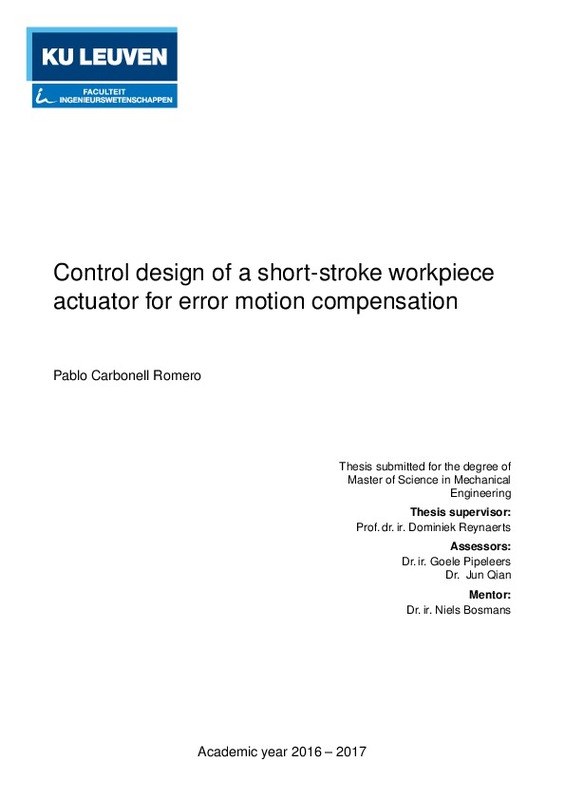|
Resumen:
|
[ES] El prototipo de una máquina rectificadora ELID de cinco ejes se está desarrollando en la KU Leuven. El alcance de esta máquina es la producción de lentes con precisión nanométrica. Para obtener este nivel de precisión, ...[+]
[ES] El prototipo de una máquina rectificadora ELID de cinco ejes se está desarrollando en la KU Leuven. El alcance de esta máquina es la producción de lentes con precisión nanométrica. Para obtener este nivel de precisión, se debe diseñar un controlador robusto para minimizar las perturbaciones del proceso. En tesis anteriores se ha estudiado e implementado un VCA (actuador de bobina móvil). El objetivo de este proyecto es diseñar un controlador que utilice el VCA para rechazar las perturbaciones creadas por las fuerzas de rectificado y otras perturbaciones. La función de transferencia del sistema debe identificarse a través de la excitación de la máquina. Una vez que se obtiene la función de transferencia, el controlador necesita ser implementado. El primer controlador diseñado es un controlador PID. También se ha diseñado un controlador de estado basado en el espacio, pero debido a un problema con el retardo de tiempo, no se ha implementado en la configuración. Durante el desarrollo del controlador, se han encontrado dos problemas: retardo de tiempo y picos de resonancia que limitan el ancho de banda. Para resolver el retraso, se implementó en la máquina una estructura de control llamada predictor de Smith. Para compensar los picos limitantes de ancho de banda, los filtros Notch se han diseñado e introducido en el esquema de control. Con los controladores que se han diseñado, el último paso es ver cómo funciona la máquina de rectificado bajo el efecto de la perturbación producida por la mesa giratoria. La mesa gira a una velocidad de 12 rpm. Al agregar los filtros notch y el predictor de Smith, se obtiene un error de 56 nm rms en una frecuencia de 260Hz.
[-]
[EN] The prototype of a five axis ELID grinding machine is being developed at KU Leuven. The scope of this machine is the production of lenses with nanometer accuracy. For obtaining this level of precision a robust controller ...[+]
[EN] The prototype of a five axis ELID grinding machine is being developed at KU Leuven. The scope of this machine is the production of lenses with nanometer accuracy. For obtaining this level of precision a robust controller has to be designed to minimize the disturbances of the process. In previous theses a VCA (voice coil actuator) was studied an implemented. The aim of this project is to design a controller that uses the VCA to reject the disturbances created by the grinding forces as well as other disturbances. The transfer function of the system has to be identified through excitation of the machine. Once the transfer function is obtained, the controller needs to be implemented. The first controller designed is a PID controller. A state space based controller has also been designed, but due to a problem with time delay it has not been implemented into the setup. While developing the controller, two problems have been encountered: time delay and bandwidth limiting resonance peaks. To solve time delay, a control structure called Smith predictor has been implemented into the machine. To compensate the bandwitdth limiting peaks, Notch filters havebeen designed and introduced into the control scheme. With the controllers that have been designed, the last step is to see how the grinding machine performs under the effect of the disturbance produced by the rotary table. The table rotates at a speed of 12rpm. By adding the notch filters and the Smith predictor, an error of 56nm rms is obtained under a frequency of 260Hz.
[-]
|







